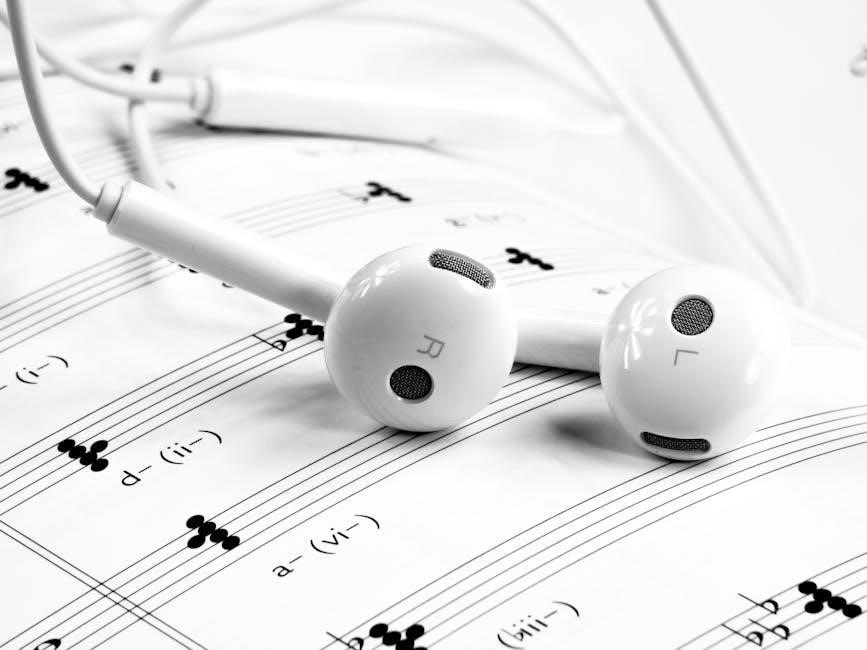
The Hallelujah Score PDF provides musicians with a detailed, downloadable arrangement of Leonard Cohen’s iconic song. Available for piano, guitar, and vocals, it offers a versatile learning tool.
Overview of the Song “Hallelujah”
“Hallelujah” is a timeless ballad written by Leonard Cohen, first released in 1984 on his album Various Positions. The song is renowned for its poetic and emotionally profound lyrics, which explore themes of love, spirituality, and existential reflection. Over the years, it has been covered by numerous artists, with Jeff Buckley’s rendition becoming particularly iconic. The song’s versatility allows it to transcend genres, from rock to gospel, making it a favorite among musicians and audiences alike. Its enduring popularity is a testament to Cohen’s masterful storytelling and the universal appeal of its haunting melody.
Importance of Sheet Music in Learning “Hallelujah”
Sheet music is essential for mastering “Hallelujah”, offering a structured guide to its melody, lyrics, and harmony. It provides clarity for musicians to interpret the song’s complex emotional layers and nuanced chord progressions. Whether for piano, guitar, or vocals, sheet music ensures accuracy and consistency, especially given the song’s multiple variations. Beginners can rely on simplified arrangements, while advanced players can explore intricate details. Access to sheet music also fosters creativity, allowing artists to adapt the piece to their style while maintaining its core essence. It serves as a valuable tool for both practice and performance, making it indispensable for learning this iconic song.

Composition and Structure of “Hallelujah”
“Hallelujah” features a timeless structure with verses and a recurring chorus, written in minor keys to evoke emotional depth. Its harmonic progression and tempo create a hauntingly beautiful melody.
Verse and Chorus Analysis
The song Hallelujah is structured with poetic verses and a memorable chorus, creating a balance between storytelling and emotional resonance. The verses explore themes of love, spirituality, and vulnerability, while the chorus serves as a cathartic refrain. Leonard Cohen’s original version includes multiple verses, each offering unique lyrical depth. The chorus, with its repetitive “Hallelujah” refrain, becomes a hauntingly beautiful anthem. This structure allows the song to flow seamlessly, building emotional intensity through its dynamic interplay of verse and chorus, making it a timeless classic for musicians and audiences alike.
Musical Key and Tempo
The song Hallelujah is typically performed in the key of C major, with a moderate tempo of around 56 beats per minute (BPM). This key and tempo create a solemn, reflective atmosphere, allowing for expressive delivery. Leonard Cohen’s original version and Jeff Buckley’s cover both use this key, though some arrangements may vary slightly. The tempo provides a steady, haunting rhythm that complements the song’s emotional depth. Variations in key and tempo exist across different covers, but the core structure remains consistent, ensuring the song’s timeless appeal and versatility for various interpretations and instrumentations.
Harmonic Progression and Chord Analysis
The harmonic progression of Hallelujah revolves around a haunting sequence of minor and major chords, creating a melancholic yet uplifting atmosphere. The song is primarily in the key of C major, with verses typically following a C-Am-F-G pattern. The chorus introduces an Em and Dm, adding emotional depth. This progression, combined with subtle modulations, gives the song its timeless appeal. Variations exist across covers, but the core harmonic structure remains consistent, allowing for interpretive flexibility while maintaining the song’s iconic feel and resonance. The chord analysis highlights the balance between simplicity and complexity, making it accessible yet profound for musicians.

Leonard Cohen’s Original Version
Leonard Cohen’s original Hallelujah was released in 1984 on his album Various Positions. Its poetic lyrics and haunting melody, accompanied by minimalistic arrangements, create a deeply emotional experience.
Historical Background of the Song
Written by Leonard Cohen in 1984, Hallelujah first appeared on his album Various Positions. Initially overlooked, the song gained widespread acclaim through covers by Jeff Buckley and others. Its poetic, emotionally charged lyrics explore themes of love, spirituality, and human struggle. Cohen’s original version features a minimalist arrangement, emphasizing the song’s lyrical depth. Over time, Hallelujah has become a timeless classic, celebrated for its universal appeal and interpretive flexibility, resonating with audiences across generations and cultures. Its enduring legacy is reflected in its numerous adaptations and performances worldwide.
Lyrics and Their Interpretation
The lyrics of Hallelujah are renowned for their poetic richness and emotional depth. They explore themes of love, spirituality, and existential struggle, blending sacred and profane imagery. Lines like, “It’s a cold and it’s a broken Hallelujah,” convey a sense of vulnerability and longing. The song’s ambiguity allows for multiple interpretations, making it universally relatable. Its verses, such as “There was a time when you let me know / What’s real and going on below,” reflect introspection and human connection. The lyrics’ timelessness and complexity have made Hallelujah a masterpiece of contemporary music, resonating deeply with listeners worldwide.
Original Sheet Music Arrangement
Leonard Cohen’s original sheet music for Hallelujah captures the song’s haunting beauty and emotional complexity. The arrangement, often in F Major, features a moderate tempo of 56 BPM, allowing for expressive delivery. The verses and chorus are structured with chord progressions that emphasize the song’s introspective nature. The original score includes piano accompaniment, with chords like C, G, and Am, creating a melancholic yet uplifting harmony. This arrangement has been widely used as a foundation for various interpretations, ensuring the song’s timeless appeal and emotional resonance for both performers and audiences. Its availability in PDF format makes it accessible to musicians worldwide.

Jeff Buckley’s Version
Jeff Buckley’s rendition of Hallelujah is iconic, known for its emotional vocals and intricate guitar work. His arrangement deviates from Cohen’s original, adding a haunting, introspective quality. The sheet music PDF captures his unique interpretation, offering insights into his performance techniques, making it a valuable resource for musicians. Buckley’s version remains a benchmark for covers of the song, blending raw emotion with musical precision, and is widely sought after by aspiring artists. Its availability in digital formats ensures accessibility for modern performers.
Popularity and Influence
Jeff Buckley’s rendition of Hallelujah catapulted the song to global acclaim, transcending genres and generations. His emotional delivery and masterful guitar techniques set a new standard, inspiring countless covers. The song’s popularity soared through its inclusion in films, TV shows, and live performances, making it a cultural phenomenon. Its influence extends to artists like Pentatonix and Rufus Wainwright, who have reimagined it in unique ways; The demand for Hallelujah score PDF has grown significantly, reflecting its enduring appeal and the desire of musicians to interpret this timeless classic. Buckley’s version remains a defining moment in the song’s legacy.
Arrangement Differences
Jeff Buckley’s arrangement of Hallelujah differs significantly from Leonard Cohen’s original. Buckley’s version features a slower tempo and a more intimate, emotional delivery, emphasizing vocal expression and subtle guitar work. His interpretation includes extended instrumental breaks and a hauntingly beautiful melody that diverges from Cohen’s simpler structure. The Hallelujah score PDF captures these distinctions, offering detailed notation for both piano and guitar. Buckley’s arrangement has become the most widely recognized, influencing many subsequent covers and solidifying its place as a modern classic. His unique take has made the song a staple in contemporary music repertoire.
Guitar and Vocal Techniques
Jeff Buckley’s rendition of Hallelujah showcases masterful guitar and vocal techniques. His fingerpicking pattern creates a soft, melodic foundation, while his vocal delivery is deeply expressive, balancing soft whispers with powerful crescendos. The Hallelujah score PDF highlights his use of minor chords and arpeggios, which evoke the song’s emotional depth. Buckley’s vocal vibrato and dynamic range add layers of feeling, making his performance iconic. The arrangement also includes intricate guitar tablature, detailing chord voicings and picking patterns. These elements combine to create a hauntingly beautiful interpretation that has inspired countless musicians to study and emulate his approach.

Other Notable Covers
Rufus Wainwright’s emotive rendition, John Cale’s minimalist interpretation, and Pentatonix’s a cappella version highlight the song’s versatility. These covers, like the original, are widely available in Hallelujah score PDF formats, offering musicians diverse arrangements to explore and perform.
Rufus Wainwright’s Version
Rufus Wainwright’s Version
Rufus Wainwright’s rendition of Hallelujah is widely acclaimed for its emotional depth and haunting beauty. His version, featured in the movie Shrek, offers a unique interpretation, blending delicate vocals with a minimalist arrangement. The sheet music for Wainwright’s version is readily available in PDF format, providing detailed notations for piano and vocal parts. This arrangement is particularly popular among singers and pianists due to its clear structure and expressive chord progressions. Wainwright’s interpretation remains faithful to Cohen’s original while adding his own distinctive flair, making it a favorite among musicians and fans alike. It is also available for free download on platforms like SheetMusic-Free.com.
John Cale’s Interpretation
John Cale’s version of Hallelujah offers a unique, stripped-down arrangement that highlights the song’s raw emotional power. His interpretation, available in PDF and MIDI formats, features a haunting piano-centric structure. The sheet music, arranged by musicgllover, includes detailed notations for solo piano, making it accessible for both beginners and advanced players. Uploaded on April 7, 2024, this arrangement emphasizes the song’s melody and harmony, allowing musicians to explore its depth. Cale’s version is particularly popular for its simplicity and clarity, making it a great resource for those seeking to master the song’s essence. It is widely available for download, ensuring accessibility for all skill levels.
Pentatonix’s A Cappella Version
Pentatonix’s a cappella rendition of Hallelujah is a captivating vocal arrangement available in PDF format. This version, arranged for soprano, alto, tenor, and bass (SATB), showcases the group’s signature harmonies and rhythm. The sheet music includes detailed vocal parts, allowing singers to replicate the song’s emotional depth. Uploaded on April 16, 2024, it features a gospel-funk style with clear tempo markings. The arrangement is ideal for vocal ensembles, blending modern a cappella techniques with the song’s timeless lyrics. Pentatonix’s version is a standout interpretation, offering a fresh, vocal-centric take on Leonard Cohen’s classic.

Sheet Music Availability
Sheet music for Hallelujah is widely available in PDF, MIDI, and other formats. Websites like SHEETSFREE.COM and Musicnotes.com offer easy downloads for various instruments and arrangements.
Free PDF Downloads
Free PDF downloads of Hallelujah sheet music are available from various online platforms like SHEETSFREE.COM and Musicnotes.com. These downloads include arrangements for piano, guitar, and vocals, catering to both beginners and experienced musicians. Many versions, including Leonard Cohen’s original and Jeff Buckley’s popular interpretation, can be accessed instantly. The PDFs often include melody lines, chords, and lyrics, making them ideal for practice and performance. Some arrangements are simplified for easier learning, while others provide more complex compositions. These free resources are a great starting point for anyone looking to master this timeless song.
Paid Sheet Music Options
Paid sheet music options for Hallelujah offer high-quality, professionally arranged scores. Platforms like Musicnotes.com and SheetMusicPlus.com provide licensed versions, ensuring accuracy and legality. These arrangements often include detailed instrumental parts, vocal scores, and multiple key options. Paid versions may feature exclusive interpretations, such as piano solos, guitar tablatures, or SATB vocal arrangements. They cater to musicians seeking precise notation and advanced compositions. Purchasing sheet music supports artists and ensures access to premium, ad-free content. These options are ideal for serious learners and performers seeking polished, reliable arrangements of Leonard Cohen’s timeless classic.
Websites Offering “Hallelujah” Sheet Music
Websites Offering “Hallelujah” Sheet Music
Several websites provide Hallelujah sheet music, catering to various skill levels and instruments. Musicnotes.com and SheetMusicPlus.com offer licensed versions, ensuring quality and legality. Other platforms like Scribd, MuseScore, and annemievanriel.be provide free and paid arrangements. These sites feature piano, guitar, and vocal scores, as well as instrumental parts for flute, violin, and more. Some offer exclusive arrangements, such asSATB vocal scores or guitar tablatures. These resources are ideal for musicians seeking versatile and reliable sheet music options to learn and perform Leonard Cohen’s iconic song.

Instrument-Specific Arrangements
The Hallelujah Score PDF offers arrangements for piano, guitar, vocals, and other instruments like flute and violin. It also includes SATB vocal scores and guitar tablatures.
Piano Solo Arrangements
Piano solo arrangements of “Hallelujah” are widely available in PDF format, offering a beautiful and intimate interpretation of Leonard Cohen’s timeless classic. These arrangements are ideal for pianists of various skill levels, from beginner to advanced. Many versions are transcribed in keys like F Major or C Major, maintaining the song’s emotional depth. Websites such as SheetMusicFree.com and PianoNanny.com provide free and paid options, ensuring accessibility for all musicians. The arrangements often include detailed fingerings, dynamics, and tempo markings, guiding pianists through the song’s iconic verses and choruses. For those seeking a challenge, more complex arrangements with intricate harmonies are also available. A must-have for pianists looking to master this beloved piece.
Guitar Tablature
Guitar tablature for “Hallelujah” is a popular choice among musicians, offering a clear and concise way to learn Leonard Cohen’s iconic song. Available in PDF format, these tabs provide chord progressions, fingerings, and lyrics alignment. Jeff Buckley’s version is particularly favored, with intricate fingerpicking patterns that capture the song’s emotional depth. Websites like SheetMusicFree.com and GuitarTabUniverse.com offer free and paid options, catering to both acoustic and electric guitarists. Whether you’re a beginner or an advanced player, these tabs guide you through the verses, choruses, and bridges, ensuring a heartfelt performance. A must-have for guitar enthusiasts seeking to master this timeless classic.
Vocal Scores (SATB)
Vocal scores for “Hallelujah” in SATB format are widely available, offering a harmonious arrangement for soprano, alto, tenor, and bass voices. These scores provide detailed dynamics, tempo markings, and lyrics alignment, making them ideal for choirs and vocal ensembles. Many arrangements, such as those by Pentatonix, feature a cappella styling, while others incorporate piano or instrumental accompaniment. Websites like Musicnotes.com and SheetMusicPlus.com offer high-quality SATB versions, ensuring a rich and emotive group performance. Perfect for vocal groups seeking to capture the song’s haunting beauty and spiritual depth.

Difficulty Levels
“Hallelujah” sheet music is available in various difficulty levels, from simplified versions for beginners to intricate arrangements for advanced musicians, catering to diverse skill sets and preferences.
Beginner-Friendly Arrangements
Beginner-friendly arrangements of Hallelujah simplify the iconic song, making it accessible for those with limited musical experience. These versions often feature basic chords and melody lines, allowing learners to focus on foundational techniques. Simplified sheet music options, such as single-line melodies or reduced chord progressions, are widely available. Many resources, including free PDF downloads and tutorials, cater specifically to beginners. These arrangements emphasize core elements of the song, enabling new musicians to grasp the emotional depth and structure of Hallelujah without overwhelming complexity. They serve as an excellent starting point for building skills and confidence.
Intermediate and Advanced Versions
Intermediate and advanced versions of Hallelujah offer richer, more complex arrangements for skilled musicians. These scores incorporate intricate harmonies, varied dynamics, and nuanced expressions, allowing for deeper artistic interpretation. For pianists, advanced arrangements may include arpeggios, sustained pedals, and layered melodies. Guitarists can explore fingerpicking patterns and chord variations that enhance the song’s emotional depth. Vocal scores for intermediate and advanced singers often feature extended ranges and harmonies. These versions challenge musicians to refine their techniques while staying true to the song’s haunting beauty. They are ideal for those seeking to elevate their performance beyond the basics.
Simplified vs. Original Compositions
Simplified versions of Hallelujah cater to beginners, offering stripped-down arrangements that preserve the song’s essence. These versions often feature reduced chord progressions, slower tempos, and straightforward melodies. In contrast, the original composition by Leonard Cohen is rich with complex harmonies, nuanced dynamics, and poetic lyrics. While simplified scores focus on accessibility, the original demands a higher level of skill and emotional depth. Both formats allow musicians to connect with the song’s timeless beauty, whether they’re learning the basics or mastering its intricate layers. This duality ensures Hallelujah remains accessible and inspiring for all skill levels.

Performance Tips
Mastering dynamics and expression is key to delivering Hallelujah effectively. Focus on emotional phrasing, subtle tempo variations, and balancing vocal intensity with instrumental accompaniment for a compelling performance.
Vocal Techniques and Expression
Mastering the emotional depth of Hallelujah requires precise vocal techniques. Focus on dynamics, transitioning smoothly between soft and powerful phrases. Use expression to convey the song’s complex emotions, ensuring each lyric resonates. Pay attention to phrasing, pausing strategically to emphasize key lines. Maintain clear diction to preserve the poetic integrity of Cohen’s words. Experiment with vibrato and tonal control to add depth, especially in the chorus. Practice breath control for sustained notes and seamless transitions between verses and choruses.
Instrumental Accompaniment Advice
For a compelling performance of Hallelujah, the instrumental accompaniment should complement the vocal delivery. The piano is a popular choice, with arpeggios or chord progressions creating a emotive foundation. Guitar arrangements, especially fingerpicking, add intimacy, blending chords with melodic lines. Strings, such as violins or cellos, can enhance depth, while woodwinds provide subtle texture. Ensure the accompaniment balances dynamics, swelling during choruses and softening in verses. Avoid overpowering the vocals; the instruments should support, not dominate. Experiment with tempo and rhythm to match the emotional intensity of the lyrics, keeping the arrangement simple yet impactful.
Emotional Delivery and Dynamics
Emotional delivery is crucial in performing Hallelujah, as the song’s depth relies on expressive interpretation. Dynamics play a key role, with soft verses building to powerful choruses. The piano or guitar accompaniment should swell during crescendos, emphasizing the song’s emotional peaks. Vocalists should focus on conveying the lyrics’ complexity, balancing vulnerability with intensity. Pay attention to phrasing, allowing moments of silence to enhance the emotional weight. The interplay between hushed tones and soaring highs creates a captivating experience. Practice dynamics to ensure the performance resonates deeply with the audience, staying true to the song’s haunting beauty while adding personal nuance.

Legal and Copyright Considerations
Using Hallelujah sheet music requires adherence to copyright laws. The song is owned by Sony/ATV Music Publishing, and proper licensing is needed for public performances or distributions.
Copyright Laws and Sheet Music
Understanding copyright laws is essential when using Hallelujah sheet music. The song, written by Leonard Cohen, is owned by Sony/ATV Music Publishing, and its use requires proper licensing. Public performances, distributions, or adaptations must adhere to copyright regulations to avoid legal issues. While some free versions are available for personal use, commercial use or modifications often require permission. It’s crucial to respect intellectual property rights and support creators by obtaining legal access to sheet music. Always verify the source and licensing terms to ensure compliance with copyright laws.
Using Sheet Music for Public Performances
Using Hallelujah sheet music for public performances requires proper licensing and compliance with copyright laws. Ensure you obtain the necessary permissions, especially for commercial or large-scale events. Many platforms offer licensed sheet music, such as PDF arrangements, tailored for performance use. Whether performing Leonard Cohen’s original version or Jeff Buckley’s interpretation, verify the licensing terms to avoid legal issues. Always purchase or download from reputable sources to guarantee authenticity and legal compliance. This ensures both artistic integrity and respect for the song’s creators.
Attribution and Licensing
Proper attribution and licensing are essential when using Hallelujah sheet music. Always credit Leonard Cohen as the original songwriter and Jeff Buckley for his popular interpretation. Licensed PDF versions ensure legal use and proper royalties to creators. Platforms like Musicnotes.com and SheetMusicPlus offer authorized arrangements, guaranteeing compliance with copyright laws. Attribution in performances or publications is crucial to avoid legal issues and respect intellectual property. Purchasing from reputable sources supports artists and ensures high-quality, accurate sheet music for musicians worldwide.
The Hallelujah Score PDF offers a comprehensive guide for musicians to master Leonard Cohen’s timeless classic. With accessible arrangements and resources, it inspires artistic expression and learning.
Final Thoughts on Learning “Hallelujah”
Learning “Hallelujah” is a rewarding journey, with its rich emotional depth and timeless appeal. Musicians can benefit from the Hallelujah Score PDF, offering detailed arrangements for piano, guitar, and vocals. Whether you’re a beginner or an advanced player, the sheet music provides a clear guide to mastering the song’s intricate harmonies and chord progressions. Embrace the song’s versatility and explore its interpretations by Leonard Cohen, Jeff Buckley, and others. Practice with dedication, and let the song’s haunting beauty resonate through your performance. The Hallelujah Score PDF is an invaluable resource for bringing this classic to life.
Encouragement for Musicians
Musicians, embrace the timeless appeal of “Hallelujah” and let its emotional depth inspire your creativity. Whether you’re a beginner or an advanced player, the Hallelujah Score PDF offers accessible arrangements for piano, guitar, and vocals. Don’t hesitate to explore its versatile interpretations, from Leonard Cohen’s original to Jeff Buckley’s iconic version. Practice with passion, and let the song’s haunting beauty shine through your performance. Remember, every note you play is a step closer to mastering this beloved classic. Share your unique voice and make “Hallelujah” your own—your musical journey awaits!
Resources for Further Study
For deeper exploration, musicians can access Hallelujah Score PDF from trusted sources like SheetMusicFree.com and Musicnotes.com. These platforms offer high-quality arrangements for piano, guitar, and vocals. Additionally, websites like Scribd and MuseScore provide a variety of versions, including covers by Jeff Buckley and Pentatonix. YouTube tutorials and forums also share tips for mastering the song. Explore these resources to enhance your understanding and performance of “Hallelujah.”